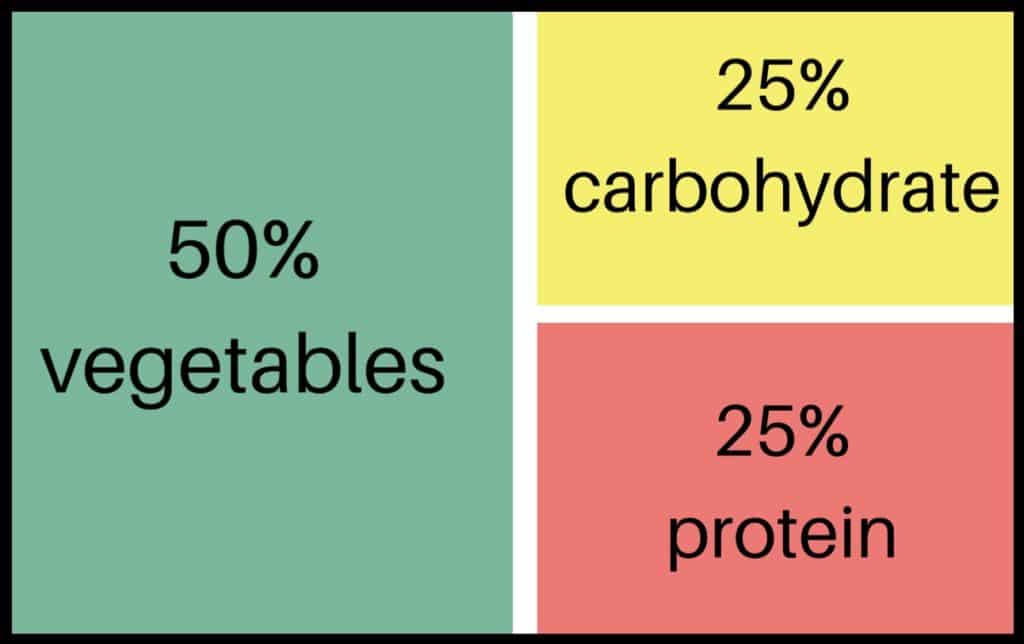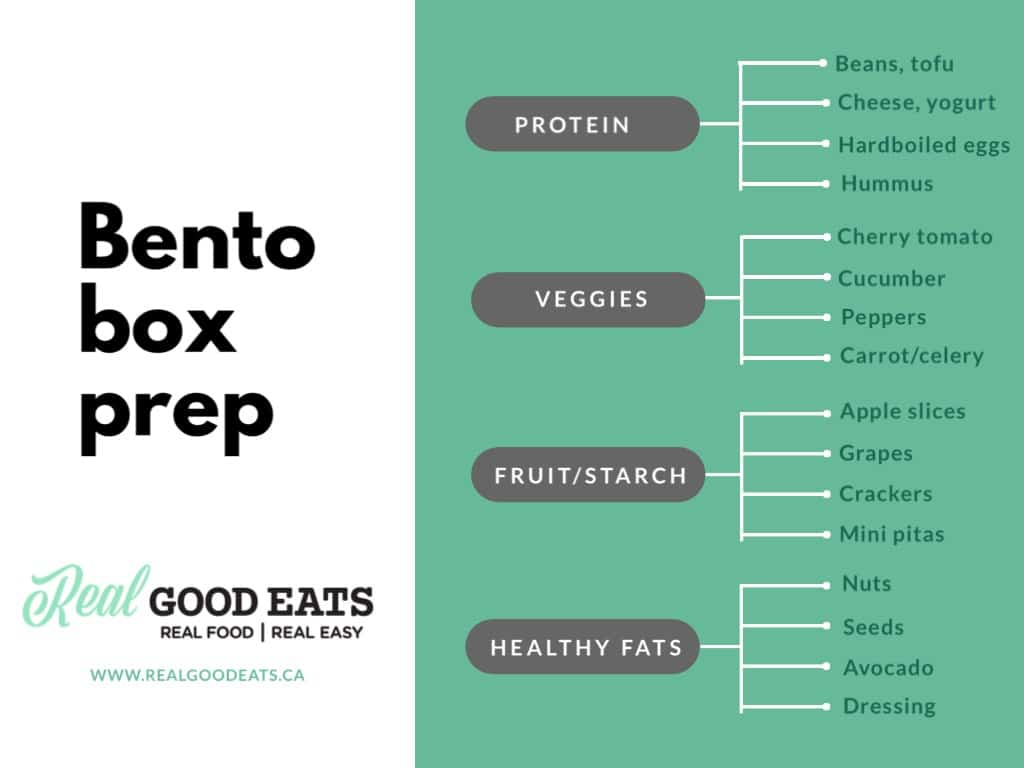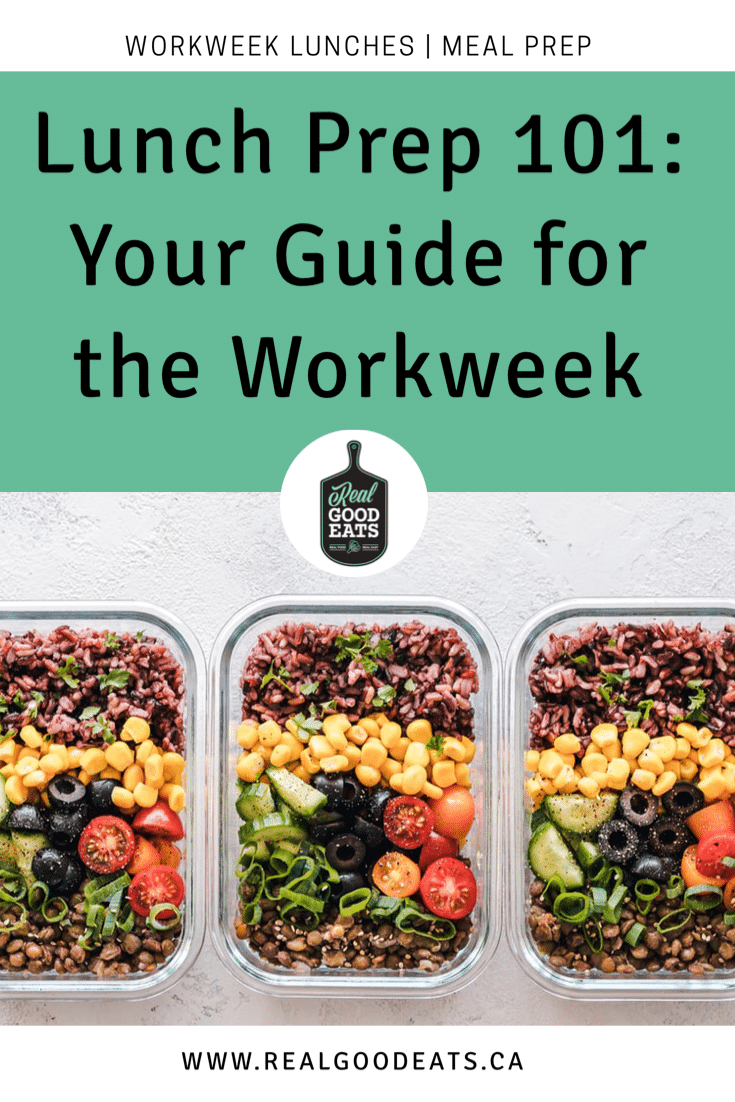It’s Tuesday night. You’ve had dinner, done the dishes, folded the laundry and are just about ready to settle into relaxation mode – until. That one last, but most dreaded, item on the to-do list creeps into your mind. Ugh, what am I going to take for lunch tomorrow?! Is this a weekly (ok, nightly?) occurrence for you? You’re not alone. We can say on good authority that herds of other working folk echo in your despair. The good news: we’re here to help! Continue reading for Lunch Prep 101: Your Go-to Guide for the Workweek.
This guide is intended to help you break down your lunchtime barriers, from packing to food prep. We will revisit some time-tested classics with a new perspective, helping you to think outside the lunchbox. To make things even easier, along with our ideas, we’ve included some simple, tried and tested recipes that will help take your prep from daunting to doable.
Lunch Prep 101: Your Go-to Guide for the Workweek
The Basics
A balanced lunch and snacks are the key to helping keep your brain fuelled and your stomach satisfied until the end of the workday. We hear an awful lot about ‘balanced meals’ – so, what does that really mean? Balance, in this case, refers to including a variety of foods, in strategic combination, with the goal of providing your brain and body with the nutrients needed to feel good, stay energized, and thrive throughout your busy workday. Feeling overwhelmed already? Stay with us! The stress and perceived time commitment associated with meal preparation (lunch or otherwise) are precisely what gets in the way for most people. We suggest using a structured approach as a guide:
For your lunch meal, think 50% veggies, 25% protein, 25% starch/carbohydrate
For your snacks, think carbohydrate/veggies + protein.

We’ll break down some examples of these, below. Keep in mind that this is a guide only. The bottom line is, there really is no ‘one size fits all’ approach to building your lunch– or any meal – that will work for everyone. Work schedules and demands will always vary from person to person. What your body needs can also vary from others.
Challenge: This week, try your best to tune in to what your body is telling you about your appetite and energy levels throughout your workday. Hungry before lunch? Energy levels dipping mid-day? Keep track. This will help you to identify the eating schedule that works for you and will ensure that you pack enough to keep you going.
Getting Started
So, how do you get started? Set yourself up for success with the following tips:
Arm yourself with the supplies that you’ll need.
Ever gone to put your leftovers away and can’t seem to find a container and lid that match? Second, only to the curse of the sole missing sock on laundry day, this is a common issue that can get in the way of your lunch prep. Do yourself a favour and Marie Kondo your Tupperware drawer at your next spare opportunity. Inventory what you’ve got and donate or recycle the odds and ends you don’t need or can’t match.
Thinking of replacing some of what you’ve got? Think reusable plastic containers that are safe for both dishwashing and microwaving in a variety of sizes (pay attention to the size of your lunch bag!); glass containers; reusable water/beverage bottle, utensils and straws; cold packs. Stocking your container arsenal with various sizes, shapes, and purposes will not only help you save time but will also go a long way in reducing the waste that is caused by single-use plastics. Win-win!
Read more about products that help reduce food-related waste.
Prepare ahead and pre-pack.
Fact: The more you plan ahead, the more time you’ll save, the less stress you will feel, and the easier this will be. Yes, it may mean a small time investment every day or once a week – depending on what works for you. But we can guarantee it will save you time -and money – in the long term.
Find the lunch bag that speaks to you.
Take some time to reflect on what you like and plan to eat during your workday. How do you like things organized? Give this some thought and then set out on the search for the lunch bag that will fit everything you need and make packing your lunch a breeze.
Consider Batch Cooking.
Batch cooking (or meal prep) refers to preparing a meal (or meals) in bulk. While the prep work and execution can feel a touch on the labour-intensive side (depending on your meals of choice), batch cooking and pre-portioning ahead of time makes for stress-free lunch assembly, as your fridge will be stocked and ready to go.
We suggest getting started by thinking about the protein sources that you have on hand, or feel like including this week. Including a protein source with your meals and snacks is your sure-fire way to keep your body feeling satisfied after eating. This can be plant-based (beans, legumes, tofu, meat alternatives, etc.) or animal-based (meats, eggs, fish) – whichever you prefer!
Regardless of what you choose, mix it up if you can! It can be helpful to batch prepare proteins that are versatile and will pair well with many different meals. For example, batch cooking chicken breasts or hard-boiled eggs that can be used in salads, sandwiches or wraps all week. Think of it this way: it will take you the same amount of time to cook one piece of chicken as it will to cook 3-4 pieces – but think of how much it will save you later in the week! Having some ready-to-go proteins on deck that require little prep time, such as canned tuna and salmon, canned beans, lentils, and other legumes, can also go a long way in reducing your prep time during your extra busy weeks.
If this sounds daunting or if you don’t have the time this week to make it happen, don’t fret. A great place to start is on a smaller scale. Why not instead, try “batch” preparing the snacks that will accompany your lunch this week? Not only will this still save you time, but it will also ensure that you have some healthy snacks on deck to keep your brain powered (3 o’clock slump, anyone?).
Snacks that batch prepare well: cut up veggies and pre-portioned dip or hummus; sliced cheese and crackers; whole-grain muffins or loaves; trail mix or other nuts; Greek yogurt; cottage cheese; fruits such as grapes, citrus fruits, whole apples, and bananas. Having a variety of healthful snacks at the ready will make room for the time in the morning needed to prepare any additional items that don’t suit being made ahead of time (and make your coffee!).
The Classics
LEFTOVERS
It seems obvious, but leftovers are truly the unsung hero, here to rescue you from your lunchtime woes. So much so, that they deserve a mention all their own, even though they will fit into many of the suggestions below. If time is your biggest barrier to prepping a balanced lunch, leftovers are your answer! It’s as simple as planning ahead for a serving or two extra of whatever you’re making for dinner tonight. Last night’s dinner can also serve as a starting point for a different meal.
Check out these 7 Ways to Reinvent your Leftovers and Cut your Cooking in Half.
Tip: Have your containers clean and ready as you serve your dinner – pack and store those extra portions right away OR freeze some for readily accessible lunches that can be defrosted on days when you’re in a pinch (think: grocery day).
SALADS
Salads often get a bad rap, however, they don’t have to be the iceberg, tomato, cucumber combination that you grew up eating (unless that’s your thing!). It’s time that we check our assumptions about salad at the door. Think of a salad as a blank canvas that can contain all sorts of nutrient-packed and delicious foods that you love. Remember what we’ve discussed about balance and don’t forget your protein!
Start with selecting your base:
Traditional lettuce/greens; vegetables; grains (pasta, quinoa, rice, etc.), and legumes (chickpeas, black beans, etc.) serve well here.
Next, toppings:
You are limited only by your imagination, here! Start with your protein (meat or meat alternatives, fish, beans, legumes, cheese, nuts). Next add any other veggies, fruit, seeds, or herbs that tickle your fancy.
Last:
Dressing/seasoning. Et voila! Doesn’t look like what salad “should look like?” No problem! Salad rules are meant to be broken.
Check out some of our favourite meal-worthy salad recipes.
SANDWICHES
Much like salads, sandwiches are often stereotyped as plain, bland, and boring. Not on our watch!
Start with your filling:
Some options we love are leftover meats, cheeses, vegetables, and mixed ‘salad’-style fillings such as tuna, chicken, egg, salmon, or chickpea salad. We love this Chickpea Salad Sandwich recipe from the Simple Veganista .
Try substituting half (or more) of your mayo with plain Greek yogurt. Not only will this offer delicious tang, but it will also significantly increase the protein content of your lunch, helping you to feel full for longer. This is especially handy for plant-based sandwiches. Feeling really creative? Jazz up Greek yogurt by adding fresh or dried herbs and spices (think: garlic, chili, cumin, salt, pepper), or some hot sauce and create your own delicious sandwich spread.
Now, the outside:
Use your imagination here! Whole grain bread, bun, lettuce (or other veggies) wraps, rice cakes, tortillas… think outside the bun! Not feeling any of these today or low on groceries? Try your fave sandwich filling with whole-grain crackers or cut up veggie sticks!
Toppings:
Many of the salad toppings mentioned above will work here too.
Tip: Not a fan of a soggy sandy? Pack wet ingredients separately and compile your sandwich right before eating.
MODERN TWIST
Bento boxes (or as we like to call it, the adult lunchable)
Originating in Japanese cuisine, Bento boxes/containers have multiple compartments, which can be filled with a variety of individual food items of your choice.
Bonus: These often do not require heating so are a great choice when on-the-go or for those without microwave access! When thinking of what to include, think protein, veggies, fruit, and a starch. Use the guide below to get started:

Feeling inspired yet? We can’t wait to see what you come up with! Tag us @realgoodeats.ca on Instagram or @realgoodeatsca on Twitter to share your not-so-boring-after-all workday meals! Happy lunching!
Don’t miss a thing! Subscribe to receive the latest recipes and healthy eating tips straight to your inbox!
[yikes-mailchimp form=”2″]
About Courtney
Courtney is a Registered Dietitian and graduate from the University of Waterloo and University of Western Ontario. Outside of her clinical day job, she has always been driven toward helping people effectively silence the loud and overwhelming “nutrition noise” that bombards us and bringing people back to the basics – real food, good nutrition, and reliable science.


